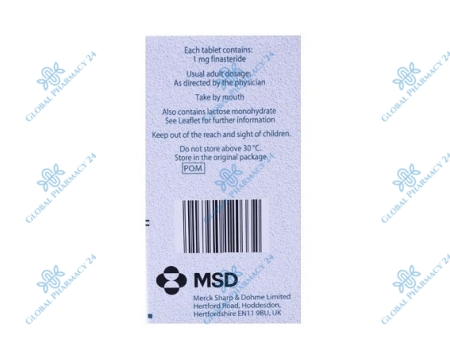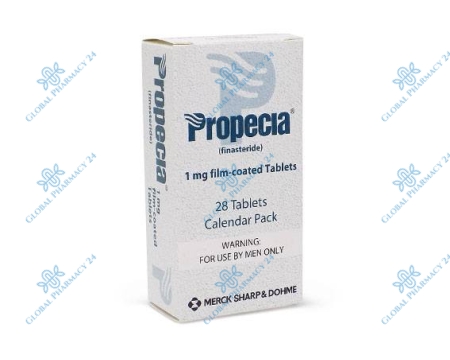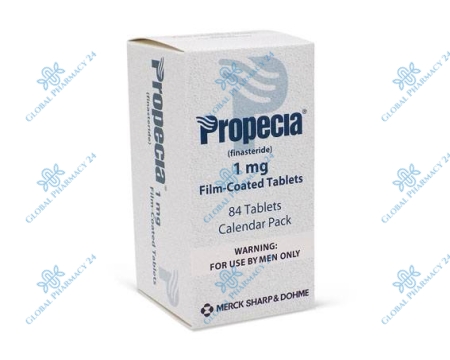| Characteristic | Detail |
|---|---|
| Active Ingredient | Finasteride |
| Dosage Form | 1 mg tablet |
| Duration of Treatment | Continuous for efficacy |
| Primary Use | Treatment of male pattern hair loss (Androgenetic Alopecia, AGA) |
| Effectiveness Timeline | 3 to 6 months for visible results |
| Prescription Status | Prescription required |
Understanding Propecia and Its Function
Propecia, known generically as finasteride, is a medication widely used for the treatment of male pattern baldness, a common form of hair loss in men. It operates by preventing the conversion of testosterone to dihydrotestosterone (DHT) in the body, a key factor in the development of hair loss. By addressing the hormonal root of hair loss, Propecia offers a targeted approach to promoting hair regrowth and preventing further hair thinning.
The significance of Propecia in the realm of hair loss treatments lies in its ability to effectively slow down the progression of androgenetic alopecia with consistent use. Unlike topical treatments, Propecia works systemically, offering a convenient and less intrusive method of managing hair loss. Its role in the broader context of hair loss management has been validated by numerous clinical studies, marking it as a cornerstone in the treatment of AGA.
What is Propecia? An Overview
Propecia is a prescription medication specifically designed for the treatment of androgenetic alopecia in men. Its active ingredient, finasteride, works by inhibiting the enzyme responsible for the conversion of testosterone to DHT, the hormone implicated in hair follicle miniaturization and hair loss. This mechanism of action underlies Propecia's effectiveness in not only halting hair loss but also in promoting hair regrowth in areas affected by AGA.
How Does Propecia Work in Treating AGA?
The efficacy of Propecia stems from its ability to lower scalp and serum DHT levels, a direct approach to mitigating the hormonal cause of hair loss in men with AGA. By reducing DHT concentrations, Propecia effectively slows the hair loss process and, in many cases, reverses it, leading to increased hair density and coverage in areas previously experiencing thinning.
The Birth of Dutasteride (Zagallo) as an Alternative to Propecia
Dutasteride, marketed under names like Zagallo, emerged as an alternative to Propecia for those seeking hair loss treatment. Similar to finasteride, dutasteride inhibits the conversion of testosterone to DHT but is distinguished by its ability to block both types of the enzyme responsible for this conversion, potentially offering a more comprehensive approach to lowering DHT levels and treating AGA.
Propecia: Prescription, Pricing, and Authenticity
Accessing Propecia involves navigating the realms of prescription requirements, understanding the costs associated with the medication, and ensuring the authenticity of the product. The prescription status of Propecia underscores the importance of a medical evaluation prior to its use, ensuring it is appropriate and safe for the individual. Pricing can vary based on factors such as location, insurance coverage, and pharmacy choice, making it essential for users to explore their options.
Authenticity is crucial in the purchase of Propecia, given the prevalence of counterfeit medications in the online marketplace. Identifying genuine Propecia involves checking packaging, product appearance, and accompanying documentation. Purchasing the medication from reputable sources is paramount to ensuring both safety and efficacy in treatment.
Prescription Costs of Propecia
The cost of Propecia can vary widely depending on insurance coverage, pharmacy pricing, and geographic location. While some insurance plans may cover the cost partially, others may not, leading to out-of-pocket expenses for the patient. Generic versions of finasteride may offer a more affordable option without compromising efficacy.
Identifying Genuine Propecia: Images and Accompanying Documents
To ensure the authenticity of Propecia, consumers should look for clear branding, secure packaging, and legitimate documentation from the pharmacy. Images of genuine Propecia tablets and packaging can be found on official websites and verified pharmacies, serving as a reference for comparison.
Propecia Prescription: Choosing the Right Hospital
Selecting the right healthcare provider for a Propecia prescription involves considering factors such as the provider's experience with AGA, the thoroughness of the evaluation process, and access to follow-up care. A reputable hospital or clinic can provide not only the prescription but also guidance on managing potential side effects and monitoring treatment progress.
Propecia’s Effectiveness, Usage, and Precautions
Propecia's effectiveness is well-documented in clinical trials, with many users experiencing a halt in hair loss and a noticeable increase in hair density. The timeline for seeing results can vary, with initial improvements often observed within the first three to six months of treatment. Consistent usage is key to maintaining and enhancing these benefits over time.
When taking Propecia, it's important to adhere to the prescribed dosage and be mindful of the medication's precautions. Skin absorption of the tablets can pose risks, particularly to pregnant women, and therefore handling guidelines must be strictly followed. Awareness and management of potential side effects are also crucial for a positive treatment experience.
Timeline: When Can You Expect Results with Propecia?
Results with Propecia typically become noticeable within three to six months of consistent daily use, with the most significant improvements often seen after a year of treatment. It's important for users to have realistic expectations and patience, as the process of reversing hair loss and promoting regrowth takes time.
Cautionary Measures: Skin Absorption and Propecia
Propecia tablets are coated to prevent contact with the active ingredient during normal handling, provided that the tablets are not broken or crushed. Pregnant women, or those who may become pregnant, should avoid handling crushed or broken tablets because of the potential risk to a male fetus.
Is Propecia a Doping Drug?
The classification of Propecia as a doping drug has been a topic of debate in the sports community. Finasteride, Propecia's active ingredient, was once included on the World Anti-Doping Agency's (WADA) list of prohibited substances because it can mask the use of performance-enhancing drugs by reducing the concentration of steroids in urine tests. However, its status has evolved as testing methods have improved, highlighting the complexities of medication use in competitive sports.
Despite its previous classification, Propecia's primary use remains the treatment of hair loss rather than enhancing athletic performance. Athletes considering Propecia should consult with sports authorities and medical professionals to ensure compliance with current regulations and to understand any potential implications for drug testing.
The Debate: Propecia and Sports Performance
While Propecia has been scrutinized in the context of sports for its potential to mask steroid use, it does not enhance physical performance or endurance. Its impact on sports performance is purely related to its ability to interfere with drug testing protocols, a concern that has been addressed with advancements in doping detection technologies.
Unraveling Propecia: Side Effects and Initial Shedding
The use of Propecia, like any medication, can be accompanied by side effects, though they are uncommon and generally reversible upon discontinuation of the drug. The most frequently reported side effects include sexual dysfunction, such as decreased libido, erectile dysfunction, and ejaculation disorders. It's important for patients to be informed about these potential side effects and to discuss any concerns with their healthcare provider.
Initial shedding is another aspect of Propecia treatment that can be concerning for users. This phenomenon, where hair loss seems to temporarily increase at the beginning of treatment, is actually a sign that the medication is working. As older hairs fall out, they make way for new, healthier growth, a process that stabilizes over time.
The Unwanted Effects: Side Effects of Propecia
Side effects of Propecia can include sexual side effects, depression, and, in rare cases, breast tenderness or enlargement. Most side effects are mild and temporary, resolving either with continued treatment or upon stopping the medication.
Understanding Initial Shedding with Propecia Use
Initial shedding with Propecia use is a temporary phase that typically occurs within the first few months of treatment. It is an indication that the medication is stimulating new hair growth, as it sheds older, weaker hairs to make room for new, stronger hairs. Patients should be encouraged to continue treatment and consult their healthcare provider if shedding persists.
Understanding the Ingredient Finasteride
Finasteride is the active ingredient in Propecia and plays a crucial role in the treatment of male pattern hair loss. By specifically targeting the enzyme 5-alpha-reductase, which converts testosterone to DHT, finasteride effectively reduces DHT levels in the scalp. This reduction is key to slowing hair loss and promoting regrowth in men with AGA.
Understanding the pharmacological action of finasteride helps in appreciating its efficacy and safety profile. The specificity of finasteride for the type II 5-alpha-reductase minimizes systemic effects, making it a targeted and generally well-tolerated option for long-term treatment of hair loss.
Finasteride: The Active Component of Propecia
Finasteride, as the cornerstone of Propecia's mechanism, demonstrates a high degree of efficacy in the reduction of scalp and serum DHT levels. Its role in altering the course of AGA through this specific hormonal intervention underscores the importance of finasteride in the landscape of hair loss treatments.
Propecia and Women: Can It Be Used?
Propecia is specifically indicated for the treatment of hair loss in men and is not approved for use in women due to potential risks during pregnancy. Finasteride can cause birth defects in a male fetus when administered to a pregnant woman. Women of childbearing age are therefore advised against using or handling crushed or broken Propecia tablets.
Research into the use of finasteride in women with hair loss is ongoing, but current guidelines recommend against its use in this population. Alternatives, such as topical minoxidil, may be considered for women experiencing hair loss, following a thorough consultation with a healthcare provider.
The Risks of Propecia Use in Women
Due to the teratogenic risk of finasteride, women who are pregnant or who may become pregnant should not use Propecia. Exposure to finasteride during pregnancy can lead to genital abnormalities in male fetuses, making it critical to adhere to safety precautions regarding the handling and use of the drug.
Propecia: Food Interactions and Contraindications
While Propecia is generally well-tolerated, it is important to be aware of potential food interactions and contraindications. The effectiveness of Propecia is not significantly influenced by food, allowing for flexibility in dosing times. However, patients should be informed about the importance of consistency in medication timing to maintain stable blood levels of finasteride.
FAQs Propecia
What is Propecia?
Propecia is a prescription medication used to treat male pattern hair loss, also known as androgenetic alopecia. It contains the active ingredient finasteride, which works by reducing the levels of dihydrotestosterone (DHT) in the scalp. DHT is a hormone that contributes to hair loss in men with male pattern baldness.
How does Propecia work?
Propecia works by inhibiting the enzyme 5-alpha reductase, which is responsible for converting testosterone into DHT. By reducing DHT levels in the scalp, Propecia helps to slow down hair loss and promote hair regrowth in men with male pattern baldness.
Is Propecia effective?
Yes, Propecia has been shown to be effective in treating male pattern hair loss. Clinical studies have demonstrated that Propecia can help to slow down hair loss and promote hair regrowth in men with androgenetic alopecia. However, individual results may vary, and it may take several months of continuous use to see noticeable improvements in hair growth.
Are there any side effects of Propecia?
Like all medications, Propecia may cause side effects in some people. Common side effects of Propecia may include decreased libido, erectile dysfunction, and decreased ejaculate volume. These side effects are usually temporary and may go away with continued use of the medication. However, if you experience any persistent or severe side effects, you should contact your healthcare provider.
Can women use Propecia?
No, Propecia is not approved for use in women. The active ingredient in Propecia, finasteride, can cause birth defects in male fetuses if it is taken by pregnant women. Women who are pregnant or may become pregnant should not handle crushed or broken Propecia tablets, as the medication can be absorbed through the skin and may cause harm to a developing male fetus.

























